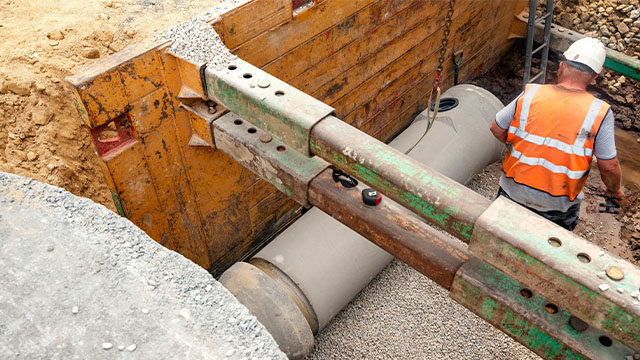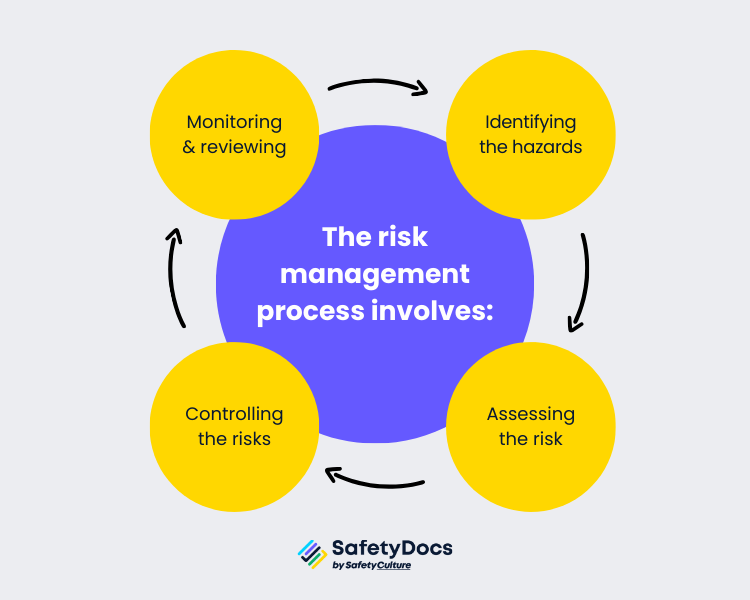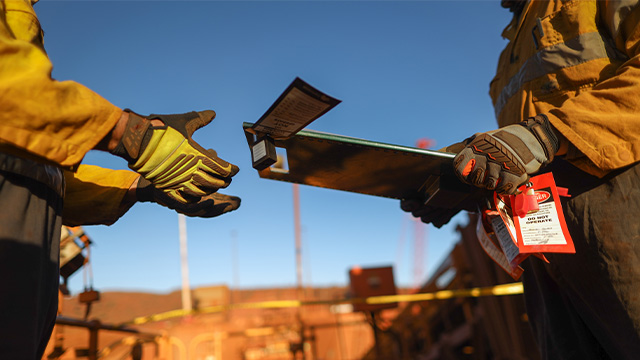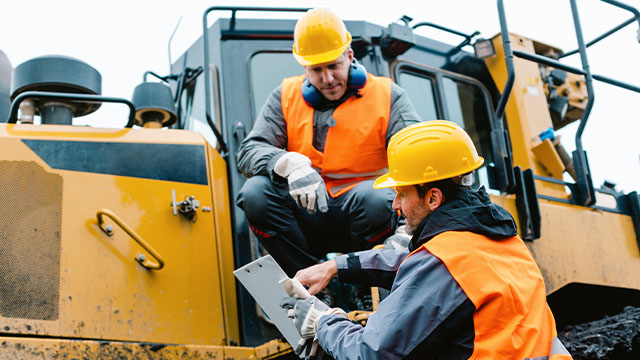Excavation work poses a multitude of dangers to workers. Some of the most common injuries stem from mobile plant incidents, contact with buried services, and being hit by moving objects, but other prevalent risks include:
- Being hit by falling objects
- Slide or cave-ins
- Being trapped between stationary and moving objects
Addressing work-related injury is crucial, emphasising the importance of implementing safety measures to prevent such injuries during excavation work.
Learn in this blog why proper excavation work safety measures are crucial for protecting workers and preventing accidents. Committing to maintaining a safe workplace is fundamental in preventing accidents and protecting workers in excavation operations, involving regular communication and consultation with workers to take their health and safety seriously.
Excavation Hazards
On June 9, 2022, a 19-year-old apprentice was seriously injured at a residential building site in Australia when a trench he was clearing collapsed, burying him in soil. He suffered multiple fractures and had to be rescued by co-workers. This incident underscores the critical importance of addressing safety issues, including the need for written safe work procedures and the significance of keeping records and reporting any workplace incidents related to safety, to enhance safety in excavation work. It serves as a stark reminder of the dangers associated with excavation works and the paramount importance of safety.
Due to the nature of this work, workers may encounter various hazards.
- Cave-ins: These are the leading cause of injuries and fatalities in excavation work. A cubic metre of dirt can easily match the weight of a car. Without proper shoring or benching, trenches and excavations are always at risk of collapse.
- Electrocutions: Underground utilities pose a constant electrocution threat. Live wires can easily be struck by tools or equipment, causing serious injury or death.
- Nasty Trench Conditions: Trenches can harbour toxic gases or chemical contamination. Pre-start atmospheric checks, gas monitors, and a buddy system can save lives.
- Equipment Hazards: Equipment failures or improper use can lead to accidents in and around the excavation site. Malfunctioning equipment can also release carbon monoxide, creating a health hazard.
- Water Hazards: Water accumulation weakens trench walls and poses drowning risks. Electrical hazards are also compounded when water is present.
- Airborne Contaminants: Gas leaks from underground pipes or tanks can create dangerous breathing conditions for workers. Carbon monoxide from combustion engines in confined excavations can also be fatal.
- Buried Contaminants: Old excavations may unearth harmful substances like asbestos or chemicals, posing inhalation and ingestion risks.
- Asbestos-Containing Material (ACM): Common in older construction materials, ACM exposure can lead to serious long-term health problems like lung cancer and mesothelioma.

When is Excavation High-Risk Construction Work?
Excavation falls under the umbrella of construction work, but specific scenarios classify it as high-risk construction work. In Australia, these scenarios include:
- Fall Hazards: Any situation where workers could fall more than 2 metres.
- Trenches and Tunnels: Work in or near the following:
- Shafts or trenches deeper than 1.5 metres.
- Any tunnel, regardless of depth.
- Mobile Plant Risks: The presence of mobile-powered machinery (excavators, loaders, etc.) when there is a risk of:
- Collisions with pedestrians.
- Collisions between pieces of machinery.
Important: If any of these conditions exist, strict construction regulations apply. A Safe Work Method Statement (SWMS) is mandatory for all high-risk work.
WHS Duties
So, who is responsible for ensuring that excavation work is carried out safely? Who needs to prepare the required documentation? The duty holders or those responsible for overseeing safe excavation work and risks include:
Persons conducting a business or undertaking (PCBUs)
A person conducting a business or undertaking (PCBU) under the WHS Act Section 19 holds the primary duty of care. PCBUs are those responsible for managing or controlling the work being done. This may include employers, self-employed persons, controllers of premises, and other people involved in the construction project.
As a PCBU, they must:
- Eliminate excavation work risks, or if not feasible, minimise them to a reasonable extent
- Manage risks related to hazardous chemicals, airborne contaminants, plant machinery, and other hazards linked to excavation work, such as trenches
- Engage workers in health and safety discussions and may also need to collaborate, consult, and coordinate with other duty-holders
Principal Contractors
As per WHS Regulations, principal contractors must prepare a WHS Management Plan outlining the procedures for developing and coordinating construction projects with a budget usually of $250,000 or more. They must also prepare safe work method statements for high-risk construction work.
The principal contractor must cooperate with the PCBU in excavation work to identify hazards, assess risks, and control them. This may involve regular communication and collaboration between parties to implement safe work practices and procedures.
Designers
Designers, manufacturers, importers, suppliers, and installers of plants or structures must ensure that the structure is safe and without risks to health and safety. Their duty includes:
- Conduct testing and analysis and provide specific information about the plant or substance.
- Consult with designers and manufacturers of plants and
- Ensure that the person who commissions construction work consults with the structure designer
Officers
Company directors must ensure that the project or undertaking complies with the WHS Act and WHS Regulations. This means they must:
- Ensure the company has the resources and processes to comply with WHS requirements.
- Monitor and review WHS performance regularly
Workers
Workers are responsible for taking reasonable care of their own health and safety and the health and safety of others in the workplace. This means they must:
- Comply with all instructions given by their employer or supervisor.
- Report any hazards or incidents that may affect health and safety.
- Use the provided PPE as instructed, based on the information, guidance, and training the employer give

Best Practices in Managing Excavation Hazards
Establishing and following safe work procedures for hazardous tasks is crucial in excavation work. To manage the risks mentioned above, here are some measures that can be implemented to mitigate the risk:
Risk Management Process
The first step in managing excavation hazards is to identify them through a thorough risk assessment procedure. This includes breaking down the overall excavation task into basic steps and specifying the personal protective equipment required for each task. Here's the breakdown of a strong risk management process:
- Identifying the Hazards: Carefully consider the specific dangers of excavation work, including:
- Cave-ins
- Falling objects
- Hazardous atmospheres
- Underground utilities
- Assessing the Risks: Analyse each hazard's likelihood and potential consequences. Consider the specific conditions of your excavation site.
- Controlling the Risks: Implement control measures based on your assessment to reduce or eliminate the hazards. Follow a hierarchy of controls, prioritising elimination and engineering solutions whenever possible.
- Monitoring and Reviewing: Regularly evaluate your control measures. Adapt them as needed to maintain a safe work environment. This proactive approach ensures your safety practices evolve with the changing conditions of the excavation.
Pre-Work Planning
Thorough planning is the foundation for a safe excavation project. Before any work begins, ensure you've addressed the following:
- Asbestos Assessment: If demolition or disturbance of existing structures is involved, determine if asbestos is present. Any suspected asbestos-containing materials must be handled by a licensed professional.
- Underground Utilities: Utilise the "Before You Dig Australia" service (https://www.byda.com.au/). This free resource helps pinpoint the location of underground assets, preventing accidental damage to power lines, pipes, and other critical infrastructure.
Key parts of the planning include:
- Safe Work Method Statements (SWMS): A principal contractor MUST prepare a SWMS for high-risk excavation work. This document outlines site-specific hazards and the control measures in place to mitigate them.
- Work Licences: Specific excavation tasks require specialised licences due to their high-risk nature. Examples include:
- Demolition
- Asbestos removal
- High-risk work activities
- Use of explosives
- Safe Entry & Exit: Clearly defined, safe entry and exit points are crucial for worker safety, especially in emergencies.
- Cave-in Protection: Trenches deeper than 1.5 metres require cave-in protection systems (e.g., shoring, benching) to prevent workers from being crushed.
- Safe Distances from Edges: Australian regulations (e.g., WorkSafe ACT) mandate a 0.9-metre buffer between stockpiled excavated materials (spoil) and the trench edge. This prevents materials from falling back in and endangering workers.
- Barriers: Physical barriers around excavations are vital to prevent falls by workers and the public.
- Water Management: Have appropriate pumping equipment on site to remove water buildup. This reduces flood and instability risks.
- Emergency Response Plan: Develop a comprehensive plan for hazards like gas leaks, cave-ins, etc. Train all workers in emergency procedures.
- Securing the Work Area: For trenches exceeding 1.5 metres in depth, the area MUST be secured against unauthorised access. This includes considering potential health hazards and the likelihood of someone intentionally or unintentionally entering the area. Securing the site is especially critical when working near public areas.

Information, training, instruction, and supervision
Under the WHS Act, a PCBU should provide all the information, training, guidance, and supervision needed to keep everyone safe at work as much as possible. This includes providing employees with the necessary knowledge and understanding of the risks associated with excavation work and how to use tools and equipment properly.
Employees must undergo training customised for excavation duties and site specifics by an expert. Proper licensing is mandatory when operating plant machinery. Supervisory roles, such as foremen, require excavation operations experience to ensure SWMS compliance.
Protective Systems
Implement protective systems such as sloping, benching, shoring, and shielding to prevent collapsing.
- Sloping: The slope angle should be appropriate according to the soil type. A lower angle for unstable soil and a steeper angle for more stable soil is sometimes acceptable.
- Benching and Battering: One easy way to control the risk of the ground collapsing is to bench or batter the excavation walls. This method creates a series of steps that prevent the soil from sliding.
- Shoring: A positive ground support, such as metal sheets or hydraulic jacks, to prevent collapse by providing lateral support to the excavation walls.
- Shielding: Using trench boxes or other types of shielding equipment can physically protect workers from potential cave-ins and falling materials.
Factors for Choosing Protective Systems
- Depth of excavation: The deeper the excavation, the more protection and support is needed.
- Soil conditions: Unstable soil or changes in soil type can increase the risk of collapse and require more extensive protective measures.
- Surrounding structures: Nearby buildings, utilities, and other structures must be considered when choosing a protective system to prevent damage.
- Weather conditions: Rain or other environmental factors can affect soil stability and may require additional support or adjustments to the protective system.
- Duration of the project: Short-term projects may only require temporary protective systems, while long-term projects may need more permanent solutions.
Essential Safety Equipment
Personal Protective Equipment (PPE)
While thorough planning and risk mitigation minimise excavation hazards, Personal Protective Equipment (PPE) remains a vital safeguard for workers. Here's the essential gear that should be on hand at your excavation site:
- Hard hats: Protect the head from falling objects and accidental impact.
- High visibility vests: Make workers easily visible and help prevent vehicle or machinery accidents.
- Steel-toed boots: Protect feet from heavy objects or sharp materials.
- Safety glasses/goggles: Protect eyes from debris, chemicals, or other hazards.
- Gloves: Protect hands from cuts, burns, and hazardous materials.
- Hearing protection: Protect ears from loud noises that can cause hearing damage over time.
- Respirators/masks: Protect lungs and respiratory system from harmful particles or fumes.
- Fall protection equipment: Including harnesses, lanyards, and anchors to protect against falls from heights.
Barricades and Signage
Placing barricades and signage in designated areas can help prevent accidents by alerting workers of potential hazards. Proper barricades and signage should be placed in construction zones, electrical areas, and hazardous materials storage areas to ensure workplace safety.
Emergency Equipment
In addition to standard first-aid supplies, ensure the following specialised emergency equipment is readily accessible at your excavation site:
- Harnesses and Lifelines: Essential for rapid retrieval of workers from trenches or confined spaces in case of collapse or atmospheric hazards.
- Emergency Communication: Have a reliable method for communication with emergency services, especially if the site is remote.
- Gas Detection Equipment: Vital for identifying and responding to potentially hazardous gas leaks.

Double the Protection with SafetyDocs
Are you confident that your excavation safety practices meet the highest standards? With SafetyDocs by SafetyCulture, you can ensure that all necessary safety documents are readily and easily accessible. Our comprehensive library of templates includes risk assessment, SWMS, emergency plans, and more. Plus, our products are always up-to-date to comply with the latest safety regulations.
Check out some of our popular excavation safety templates:
- Excavation Management Plan
- Excavation Safety Inspection Checklist
- Excavation Collapse Emergency Response Plan
- Earthmoving & Mobile Plant Safe Work Method Statements (SWMS)
Don't let your excavation site become a danger zone—Trust SafetyDocs to help you double the protection for your workers and project site. Contact us today for personalised advice on your specific excavation safety needs.
Our team of experts is dedicated to providing accurate and informative content. Craig Cruickshank, our senior HSEQ advisor at SafetyDocs by SafetyCulture has reviewed this blog post to ensure the highest level of quality.
Learn more about Craig's work on LinkedIn for more industry insights.
Available for instant download and supplied in fully editable MS Word format for use in your business.
Please note that the above information is provided as a comment only and should not be relied on as professional, legal or financial advice.
Share This Article
